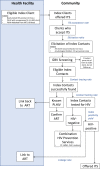Index and targeted community-based testing to optimize HIV case finding and ART linkage among men in Zambia
- PMID: 32589360
- PMCID: PMC7319128
- DOI: 10.1002/jia2.25520
Index and targeted community-based testing to optimize HIV case finding and ART linkage among men in Zambia
Abstract
Introduction: Current healthcare systems fail to provide adequate HIV services to men. In Zambia, 25% of adult men living with HIV were unaware of their HIV status in 2018, and 12% of those who were unaware of their HIV statu were not receiving antiretroviral therapy (ART) due to pervasive barriers to HIV testing services (HTS) and linkage to ART. To identify men and key and priority populations living with HIV in Zambia, and link them to care and treatment, we implemented the Community Impact to Reach Key and Underserved Individuals for Treatment and Support (CIRKUITS) project. We present HTS and ART linkage results from the first year of CIRKUITS.
Methods: CIRKUITS aimed to reach beneficiaries by training, mentoring, and deploying community health workers to provide index testing services and targeted community HTS. Community leaders and workplace supervisors were engaged to enable workplace HTS for men. To evaluate the effects of these interventions, we collected age- and sex-disaggregated routinely collected programme data for the first 12 months of the project (October 2018 to September 2019) across 37 CIRKUITS-supported facilities in three provinces. We performed descriptive statistics and estimated index cascades for indicators of interest, and used Chi square tests to compare indicators by age, sex, and district strata.
Results: Over 12 months, CIRKUITS tested 38,255 persons for HIV, identifying 10,974 (29%) new people living with HIV, of whom 10,239 (93%) were linked to ART. Among men, CIRKUITS tested 18,336 clients and identified 4458 (24%) as HIV positive, linked 4132 (93%) to ART. Men who tested HIV negative were referred to preventative services. Of the men found HIV positive, and 13.0% were aged 15 to 24 years, 60.3% were aged 25 to 39, 20.9% were aged 40 to 49 and 5.8% were ≥50 years old. Index testing services identified 2186 (49%) of HIV-positive men, with a positivity yield of 40% and linkage of 88%. Targeted community testing modalities accounted for 2272 (51%) of HIV-positive men identified, with positivity yield of 17% and linkage of 97%.
Conclusions: Index testing and targeted community-based HTS are effective strategies to identify men living with HIV in Zambia. Index testing results in higher yield, but lower linkage and fewer absolute men identified compared to targeted community-based HTS.
Keywords: HIV care continuum; HIV testing; differentiated care; finding men; index testing services; linkage to care; sub-Saharan Africa.
© 2020 The Authors. Journal of the International AIDS Society published by John Wiley & Sons Ltd on behalf of the International AIDS Society.
Figures




Similar articles
-
Peer community health workers improve HIV testing and ART linkage among key populations in Zambia: retrospective observational results from the Z-CHECK project, 2019-2020.J Int AIDS Soc. 2022 Nov;25(11):e26030. doi: 10.1002/jia2.26030. J Int AIDS Soc. 2022. PMID: 36317821 Free PMC article.
-
Reaching transgender populations in Zambia for HIV prevention and linkage to treatment using community-based service delivery.J Int AIDS Soc. 2022 Oct;25 Suppl 5(Suppl 5):e25995. doi: 10.1002/jia2.25995. J Int AIDS Soc. 2022. PMID: 36225155 Free PMC article.
-
HIV testing and treatment coverage achieved after 4 years across 14 urban and peri-urban communities in Zambia and South Africa: An analysis of findings from the HPTN 071 (PopART) trial.PLoS Med. 2020 Apr 2;17(4):e1003067. doi: 10.1371/journal.pmed.1003067. eCollection 2020 Apr. PLoS Med. 2020. PMID: 32240156 Free PMC article.
-
The cascade of care following community-based detection of HIV in sub-Saharan Africa - A systematic review with 90-90-90 targets in sight.PLoS One. 2018 Jul 27;13(7):e0200737. doi: 10.1371/journal.pone.0200737. eCollection 2018. PLoS One. 2018. PMID: 30052637 Free PMC article.
-
Understanding effective post-test linkage strategies for HIV prevention and care: a scoping review.J Int AIDS Soc. 2024 Apr;27(4):e26229. doi: 10.1002/jia2.26229. J Int AIDS Soc. 2024. PMID: 38604993 Free PMC article.
Cited by
-
Health worker acceptability of an HIV testing mobile health application within a rural Zambian HIV treatment programme.PLoS One. 2025 Jun 5;20(6):e0312646. doi: 10.1371/journal.pone.0312646. eCollection 2025. PLoS One. 2025. PMID: 40472011 Free PMC article.
-
Mixed-methods protocol for the WiSSPr study: Women in Sex work, Stigma and psychosocial barriers to Pre-exposure prophylaxis in Zambia.BMJ Open. 2024 Sep 5;14(9):e080218. doi: 10.1136/bmjopen-2023-080218. BMJ Open. 2024. PMID: 39242170 Free PMC article.
-
Prevalence of and factors associated with late diagnosis of HIV in Malawi, Zambia, and Zimbabwe: Results from population-based nationally representative surveys.PLOS Glob Public Health. 2022 Feb 22;2(2):e0000080. doi: 10.1371/journal.pgph.0000080. eCollection 2022. PLOS Glob Public Health. 2022. PMID: 36962254 Free PMC article.
-
Effect of index HIV self-testing for sexual partners of clients enrolled in antiretroviral therapy (ART) programs in Malawi: A randomized controlled trial.PLoS Med. 2023 Aug 4;20(8):e1004270. doi: 10.1371/journal.pmed.1004270. eCollection 2023 Aug. PLoS Med. 2023. PMID: 37540649 Free PMC article. Clinical Trial.
-
Addition of HIV self-test kits to partner notification services to increase HIV testing of male partners of pregnant women in Zambia: two parallel randomised trials.Lancet Glob Health. 2021 Dec;9(12):e1719-e1729. doi: 10.1016/S2214-109X(21)00393-4. Epub 2021 Nov 1. Lancet Glob Health. 2021. PMID: 34735862 Free PMC article. Clinical Trial.
References
-
- UNAIDS . Global HIV & AIDS statistics — 2019 fact sheet. 2019.
-
- Zambia Statistics Agency, Ministry of Health Zambia, ICF . Zambia demographic and health survey 2018. Lusaka, Zambia, and Rockville, MD: Zambia Statistics Agency, Ministry of Health, and ICF; 2019.
-
- Ministry of Health Zambia . Zambia population‐based HIV impact assessment (ZAMPHIA) 2016: final report. Lusaka, Zambia: Ministry of Health; 2016.
Publication types
MeSH terms
Substances
Grants and funding
LinkOut - more resources
Full Text Sources
Medical

